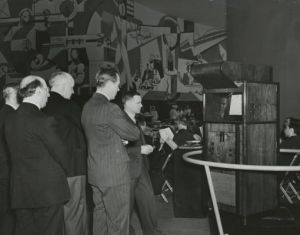Television developed quickly beginning in the 1880s when The Scientific American magazine published a piece on the concept of a working television. However, it wasn’t until 1927 when Philo Farnsworth created the first working model. Despite a war in the patent war, David Sarnoff began marketing the television to the masses and is now known as the father of television.

The first successful TV broadcast allowed the world to view the New York World’s Fair in 1939. During the broadcast, President Franklin D. Roosevelt delivered a speech to thousands of anxious Americans to introduce them to the power of TV. Shortly after this production, the RCA had the first mass wave of television sets sold in 1947.
Americans then began owning televisions and in 1948 Douglas Edwards began the CBS TV News with the help of his producer Don Hewitt. CBS TV News began a huge momentum within television news broadcasting.
- 1948: Douglas Edwards began the CBS TV News
- 1949: KTLA broadcast the Kathy Fiscus rescue attempt for 27 hours
- 1950: The Kefauver Committee hearings on organized crime in America were broadcast for 15 months, from May 1950 to July 1951
- 1951: Nov. 18 was first TV broadcast of See It Now, produced by Fred Friendly and directed by Don Hewitt in magazine format, broadcast coast-to-coast using newly-completed coaxial cable
- More of this timeline can be found here.
Television at this time amazed its audience, but actually it was very simple. The broadcasts mainly featured one anchor reading news updates off a piece of paper, as teleprompters were not created until later. And graphics were minimal, sometimes including a still picture and very rarely anything more. But in the early years, television didn’t need to be fancy, because the invention itself wowed its audience.
Television became more and more valuable as the business grew. A great example of that is just how influential television was in the first broadcasted Presidential debate of 1960. Both candidates, John F. Kennedy and Richard Nixon, took part in what is now known at the “Great Debate,” which can be seen below.
This “Great Debate” made TV all the more popular as well as television news. The mass population could hear news directly from the source and see it at the same time. Not only did this change the way news was reported for television, but it increased the need for timeliness in the media world.
Television was a huge invention that is still morphing today. Local news and national news are experimenting with new ways to gain profit from advertising, and searching earnestly to connect their audience to the news around them.